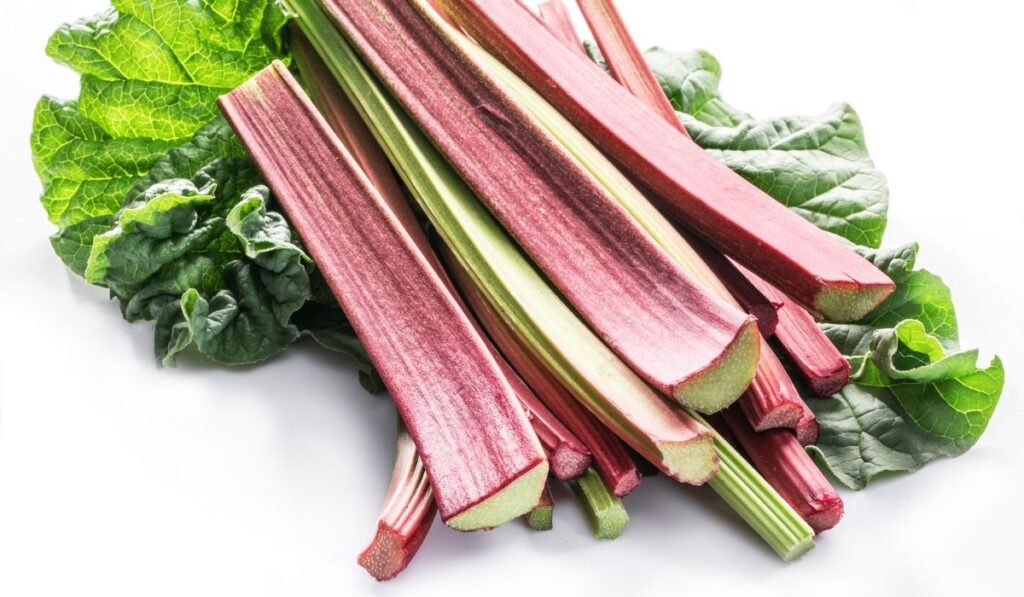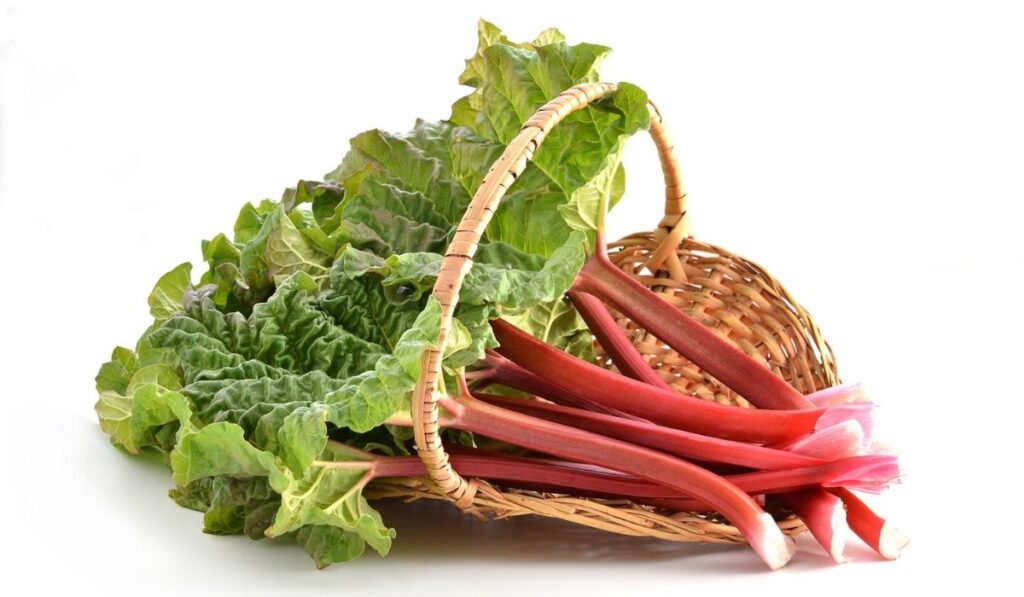Adding seasonal fruits and vegetables to your diet is an excellent way to increase nutrition and variety. Rhubarb is a seasonal plant that’s often mistaken for a fruit. But this vibrant pink vegetable offers multiple health benefits and is only available a few months out of the year.
Rhubarb is available from March through July. Rhubarb thrives in the upper region of the US or in colder climates. The pink stalks can be eaten raw, have an acidic taste, and are typically paired with sugar. Rhubarb leaves are toxic and should not be consumed.
If you missed out on rhubarb season last year, you’d better be prepared for the next one! Incorporating this seasonal vegetable into your diet can add color, diversity, and health benefits. Here’s the guide to rhubarb and everything you need to know.
What Is Rhubarb?

Rhubarb is a spring vegetable native to Asia. Although rhubarb is a vegetable, many people use it as a fruit in recipes.
The only part of rhubarb that’s edible is the long and vibrant pink stalk. Rhubarb leaves contain different toxins and high amounts of oxalic acids, which can be dangerous to consume.
The stalks have a fleshy consistency, somewhat like celery. Raw rhubarb is safe to consume, but it’s very sour and acidic.
Many people prefer to cook rhubarb with sugar to reduce the acidity. The flavor becomes delightfully tart like a green apple with a hint of a vegetal flavor. Rhubarb is often paired with strawberries for these reasons.
Is Rhubarb Available All Year Round?
Unfortunately, rhubarb is not available all year and can only be enjoyed a few months out of the year. Rhubarb starts to show up in spring, around March and April, and lasts through most of the summer, ending in July.
Rhubarb does well in cooler climates, including much of the northern US — from Maine to Oregon — and it’s quite big in Alaska.
If you’re having trouble finding fresh rhubarb, be sure to consider shelf stable options like the canned Oregon Fruit Rhubarb in Strawberry Sauce (on Amazon). You won’t find dried rhubarb you can use as a direct replacement in recipes, but rhubarb tea, and even rhubarb bitters for cocktails (both on Amazon) can help you get your fix in the off-season!
Is It Safe to Eat Raw Rhubarb?
The vibrant pink rhubarb stalks are safe to eat raw and cooked. However, rhubarb leaves are poisonous and unsafe for consumption as they contain high amounts of oxalic acid. Oxalic acid is an organic compound found in stain removers, metal polish, and ink.
If you eat rhubarb leaves in large amounts, you might experience mild gastrointestinal symptoms or severe health complications, such as kidney failure. It’s best to remove all rhubarb leaves before preparing or eating the vegetable.
Is Rhubarb Good For You?

Rhubarb is an excellent seasonal vegetable to include in your diet. Although this vibrant vegetable isn’t as nutrient-dense as some other options, it’s a terrific source of vitamin K.
Rhubarb is also low in calories and high in fiber. Here are some more health benefits of this vegetable:
Great Source of Vitamin K
Rhubarb is a great choice when it comes to vitamin K, offering around 25% to 35% of the recommended daily value in a 100-gram serving. Vitamin K is an integral compound for bone health and blood clotting.
Great Source of Vitamin A
Rhubarb also contains vitamin A, a powerful compound that can help fight free radicals that cause skin damage or premature aging.
This means eating rhubarb might help keep your skin looking more healthy and youthful over the long run. Rhubarb also has high amounts of antioxidants, vitamins, and minerals that can offer a variety of health advantages.
May Improve Bone Health
Rhubarb can help improve bone health due to the high amounts of vitamin K. Vitamin K aids in maintaining strong and healthy bones, as well as producing healthy bone tissue. Vitamin K can also prevent osteoporosis, a condition in which the bones become weak and brittle.
May Protect Heart Health
Adding rhubarb into your diet may help to protect and improve your heart. Rhubarb is a great source of fiber, which can help lower cholesterol. Fiber can help lower bad cholesterol levels as well as total cholesterol, reducing the risk of heart disease and heart attack in the process.
The vitamin K in this pink vegetable may also help in preventing the calcification of blood vessels. Finally, the antioxidants found in rhubarb can provide anti-inflammatory effects.
May Help Digestion
Rhubarb is an excellent source of fiber. Fiber helps things move through your digestive tract, but it also offers many other health benefits. Fiber can prevent or ease constipation, reduce the risk of colorectal cancer, lower cholesterol levels, and even help you lose weight.
Not to mention, this pink vegetable contains compounds known as sennosides, which operate as natural laxatives. The tannins in rhubarb may also offer anti-diarrheal properties.
May Prevent Cancer
Rhubarb contains antioxidants — substances that can prevent or decrease damage to cells caused by free radicals. Free radicals are unstable molecules produced in the body that can cause oxidative stress, which has been linked to serious illness and cancer.
The antioxidant and free radical-fighting elements of rhubarb might decrease the risk of developing different types of cancer.
May Reduce Inflammation
Antioxidant compounds found in rhubarb may help defend against inflammation. Chronic inflammation has been linked to heart disease, diabetes, cancer, and other severe health complications.
Antioxidants may be especially useful to individuals suffering from systemic inflammatory reaction syndrome. Other research found that rhubarb extract might help improve wound healing and offer anti-inflammatory elements.
